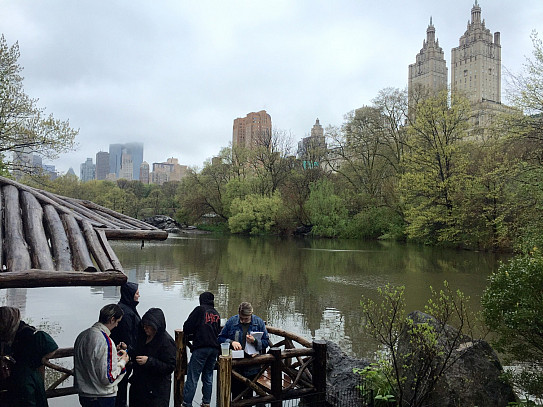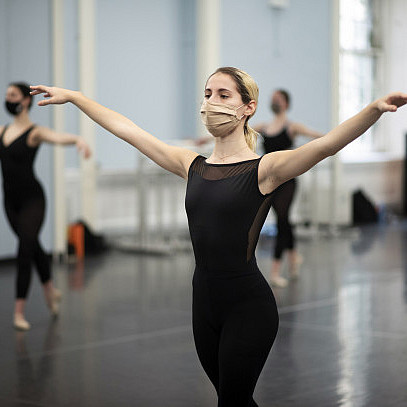Dancing at a Distance: Dance Education During COVID-19
With the reopening of MMC’s Main Campus during the Fall 2020 semester, the Department of Dance was challenged with continuing instruction in a discipline characterized by live performance. Following the Virtual/Open Campus model of education, dance instruction persevered via the addition of new equipment, implementation of health and safety protocols, and the determination of MMC students and faculty.
Socially Distant Dancing

Students using the studio space, such as senior Dance and Biomedical Sciences double major Emily Brennan ’21, say that they feel safe attending in-person classes. “The dancers have done an excellent job of maintaining distance and wearing masks as much as possible,” says Brennan. “We all really care about keeping the school safe because we know if cases start spreading we will lose access to the incredible studio spaces at Marymount.”

Some students such as Amanda Moreira ’22, a junior BFA in Dance major with a Modern Dance Concentration, find remote learning to provide certain benefits. “It allowed me to really focus on myself and how movement affected my body,” says Moreira. This was not without challenge, however, as Moreira and other students have expressed difficulty in dancing within limited apartment spaces. Brennan and Moreira both have also noted that working in the studio provides energy and a sense of community that is critical in dance instruction.
“In-studio training for the dancers was extremely advantageous,” says Associate Professor of Dance and Chair of the Dance Department, Nancy Lushington. “Those dancers could be inspired and motivated not only by their instructors, but also by their peers. Dance is a visual art form and the ability to consistently observe and absorb feedback from faculty and witness the effect of that on other dancers in the room was key in their growth over the past semester.”
Digitized Dance Instruction

Gabrielle Willis ’21, senior BFA in Dance major with a Modern Dance concentration, expresses that although not having an instructor in the same room appears more challenging, the faculty are working hard to empower her and her classmates “All of our faculty has done a wonderful job of making everyone feel seen with personal corrections and feedback,” says Willis.
“All the teachers really took the time to make sure that everyone was being seen,” adds Moreira. “Our professors still pushed us as artists to continue to grow, experiment, and play with movement.”
Student Experience
Although Brennan found the Fall 2020 semester to be an incredible challenge, she found that being able to share space and classes with fellow dancers made up for all the masks and protocols. “The instructors have been so helpful in making this transition smooth and they put as much effort as possible into giving us the individual corrections that we need and maintaining the level of training we would receive in a normal class,” says Brennan.

“The dance studios provide a professional atmosphere where dancers feel inspired and encouraged while performing within their classes,” explains Rifkin. Despite the virtual format, Rifkin believes she and her peers have adapted well to the new environment. “Despite our professors’ physical absence within our classes, I strongly feel as if they are focused on addressing each student’s endeavors within their dancing. Regardless of where I am taking class, my professors and peers have individually impacted me to excel to my fullest potential.”
This story is part of a larger series, MMC Together, published by Marymount Manhattan College’s Communications team. Have questions or a story lead? Email Communications@mmm.edu.
Published: February 16, 2021
